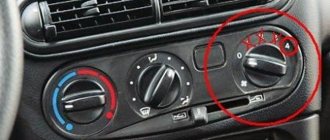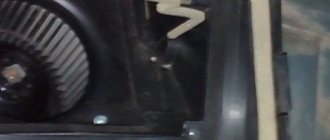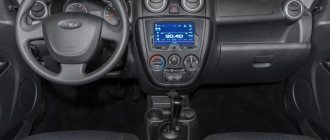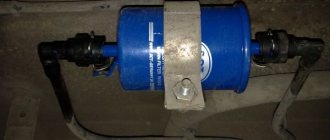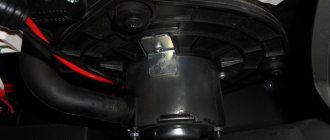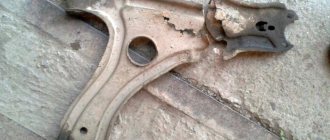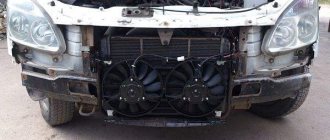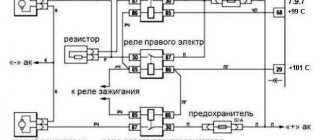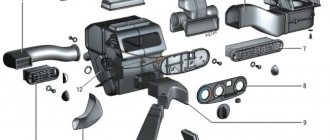A breakdown of the stove fan on a Chevrolet Niva is perhaps the worst thing that can happen to a driver who is far from home in thirty-degree frost. However, such a turn of events can be avoided. The main thing is to pay attention in time to the characteristic signs indicating that the stove fan will soon fail. And after that, you can replace the device yourself without exposing yourself to the risk of frostbite.
- 2 Signs of malfunction of the Chevrolet Niva heater fan
- 3 Replacing the heating fan fuse
3.1 Sequence of actions
- 4.1 Replacement sequence
Location of the heater fan on the Chevrolet Niva
The heater fan is located in a special niche under the cabin filter, just below the windshield of the car. Under its impeller there is an electric heater motor connected to the on-board electrical network and to the vehicle's safety unit.
The Chevrolet Niva heater fan impeller is located under the cabin filter and is marked with the number 15
If the owner of a Chevrolet Niva decides to replace the heater fan, then it can be removed in two ways: through the interior of the car, partially disassembling the dashboard, or through the hole in the cabin filter (but before that you will have to remove the filter itself, of course). The second method will be discussed below, since it is considered the least labor-intensive and even a novice driver can use it.
Symptoms of a malfunctioning stove fan
The main signs of a stove fan failure are as follows:
- the electric motor does not work;
- the rotation speed of the electric motor decreases;
- The fan starts to creak.
Depending on the symptoms that appear, the procedure for eliminating the problem is determined.
The electric motor does not work
If the electric motor stops working, the noise in the cabin disappears when the heater is turned on.
Often the reason for this is the failure of fuse F18 with a rating of 25A in the corresponding block, through which voltage is supplied to the stove motor.
Another reason may be damage to the fan motor winding - if the wire insulation is damaged, an interturn short circuit may occur. In this case, the electric motor must be replaced.
This is interesting: Overtaking on the right
When there is an interturn short circuit, the electric motor stops working.
The rotation speed of the electric motor decreases
When the rotation speed of the motor shaft decreases, it is somewhat more difficult to determine the source of the problem. The noise level becomes noticeably lower as the motor power decreases. This may be due to severe wear on the armature or brushes. In addition, the fan begins to consume much more current, and this can lead to the failure of fuse F18.
If the armature is heavily worn, the electric motor will rotate much more slowly.
The fan starts to creak
The fan begins to creak when the motor bearings wear out. The more wear, the stronger the squeak. If you do not take any action, the heater fuse will burn out and the motor itself will jam. In this case, the electric motor should be replaced with a new one.
If the bearings are worn too much, the engine seizes up.
Replacing the heater fan fuse
Almost any malfunction of the stove motor leads to the replacement of fuse F18. On a Chevrolet Niva car, the fuse box is located in the passenger compartment under the instrument panel and is closed with a cover secured with two self-tapping screws. When replacing F18, it is recommended to check and, if necessary, replace other fuses.
The heater fuse is located in the fuse box under the instrument panel
If fuse F18 has to be changed quite often, then the problem should be looked for elsewhere. There may be a short circuit somewhere in the motor power supply circuit. Sometimes the fuse blows as a result of severe contamination of the cabin filter. In this case, the electric motor does not have enough power for normal air ventilation, and the fuse fails.
Often the cause of the heater motor stopping is a blown fuse.
The suspicious fuse is removed from its seat in the block using special tweezers. If it burns out, a new one is installed in its place. When checking, it is better to use a multimeter, since it can be difficult to visually determine the integrity of the fuse.
The heater fuse on the Chevrolet Niva (F18) is rated at 25 A
Video: replacing the heater fuse
Signs of malfunction of the Chevrolet Niva heater fan
There are several typical signs by which a driver can understand that something is wrong with the fan. Here they are:
- the fan does not rotate. It’s impossible not to notice this, because the car’s interior suddenly becomes unusually quiet. This problem occurs when fuse F18 in the safety block, which is responsible for the electrical circuit of the fan motor, fails. In addition, the winding on the fan motor itself may be damaged. For example, the insulation on it may be broken, after which the adjacent turns short-circuit;
The adjacent turns on the Chevrolet Niva fan winding shorted and the motor burned out
- reducing fan speed. It is much more difficult to notice such a malfunction. With this breakdown, the electric motor of the stove continues to work, but not at full power. An experienced driver with good hearing will understand that the heater fan has begun to make a different noise. This means that the rotation of the shaft is greatly hampered by worn brushes or a commutator. The problem is that a motor with such a breakdown consumes more current. And this, in turn, can damage fuse F18;
- fan creaking. It occurs when the bearings in an electric motor wear out. Moreover, as the bearings deteriorate, the creaking gradually increases, turning into a grinding sound. If the driver does nothing, the fan will simply stop and fuse F18 will burn out. In the event of this breakdown, the car owner will have to replace the entire electric motor, since it is not possible to find bearings for it on sale.
Removing and replacing and installing the heater fan on the Niva VAZ-21213 and VAZ-21214
Dear friends, today we will tell you how to independently remove and install the electric motor of the stove fan on the Niva VAZ-21213 and VAZ-21214. The procedure is quite simple; we only need two screwdrivers, a Phillips screwdriver and a flathead screwdriver with a thin blade. The reason for removing and replacing the heater motor may be its squealing due to wear on the bushings. Often even new heater motors suffer from this problem, so when replacing the heater motor, we recommend that you install a bearing motor. To get to the motor we need to remove the lower part of the stove body, and to get to it we need to remove the shelf, the radio panel and the decor on the tunnel.
In general, let's get started, and start by removing the storage shelf under the glove compartment, pick up a Phillips screwdriver and unscrew the following screws:
We move the shelf to the side. Then we move on to the decorative trim on the tunnel, it is also held in place by screws, they are located in this way, see the photo below:
Carefully remove the chips from the cigarette lighter, put the tunnel decor aside, we don’t need it for now. Now let's move on to the tape recorder panel. To begin, use a flat screwdriver to pry up the buttons one by one:
Carefully remove the terminals from them and move all the buttons to the side. We recommend labeling the terminals, this will speed up the assembly process and help avoid mistakes!
Gently pull the plastic nozzles of the stove levers towards you, they will come out with force:
Now again we take the Phillips screwdriver in our hands and unscrew the fastenings of the radio panel to the dashboard on both sides:
Then use a flat screwdriver to pry the panel from above and carefully remove
Now we have access to the stove body. But first, we unscrew the rotation relay to remove the minus chip of the heater fan from it:
Now we are interested in the metal latches of the stove, here they are in the photo, there are only 4 of them, two on each side:
They can be removed either by hand or by prying them with a screwdriver. Be careful, they are springy and can fly away in an unknown direction, to the land of lost things
After this, the lower part of the stove body falls into our hands and is calmly removed, we gain access to the culprit of the action - the stove motor:
It is also held on by two metal latches; it is more convenient to pry them off with a screwdriver:
After this, disconnect the motor wiring and remove it from the stove body
We remind you that the heater motor is essentially irreparable and if it “squealed” then the bushings are damaged and then only a replacement is needed. Ideally, straight to the bearing. When assembling and installing, do not forget to put rubber spacers on the motor, otherwise vibration will occur. We perform assembly in reverse order. So you have learned how to independently remove and install the heater motor on the Niva VAZ-21213 and VAZ-21214. Good luck to everyone on the roads and fewer breakdowns.
Replacing the stove fan
Replacing a heater motor is quite simple.
Required Tools
To work you will need:
- set of hex keys;
- Phillips screwdriver;
- new electric heater motor.
This is interesting: New Range Rover Sport
Removing the stove fan
The stove fan is removed as follows.
- The negative terminal of the battery is disconnected.
- On the right (in the direction of travel) under the windshield there is a cabin filter protected by a snap-on lid. After removing the cover and removing the filter, access to the heater fan is available.
To access the heater fan, the cabin filter is removed - The impeller is removed. To do this, use a Phillips screwdriver to unscrew the bolt holding the mounting bracket. The impeller moves to the side and is removed.
To remove the impeller, you need to unscrew the bolt and remove the mounting bracket - In the cabin, in front of the passenger seat, the fastening of the glove compartment panel is unscrewed.
To access the electric motor, the glove box panel is removed - The connector with the power wires is disconnected.
To remove the electric motor, you must disconnect the connector with the power wires - Use a short 10mm hex to unscrew the mounting bolts and remove the electric motor.
The heater motor is secured with three bolts - After removing the engine, the impeller is carefully removed through the cabin filter niche.
The impeller can be pulled out freely from the cabin filter side
Installing a stove fan
The faulty electric motor is repaired or replaced with a new one. A damaged impeller should also be replaced. A thin wire is threaded through the holes in its body and the cavity of the cabin filter is secured. The impeller must be installed in such a way that the groove located inside it fits into the pin of the electric motor shaft.
Before installing a new engine, the axle is lubricated with a special lubricant.
Assembly is performed in reverse order. If the impeller does not fit into place, it should be moved several times in different directions until it is completely seated on the motor shaft. Then, under the hood, the wire is cut with wire cutters, the mounting bracket is installed and the bolt is tightened. New heater fan installed.
Thus, diagnosing faults, repairing and replacing the heater fan on a Chevrolet Niva is not very difficult. This will require a minimum set of standard tools. Keep an eye on the stove, and the inside of your car will always be warm.
